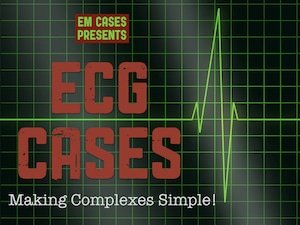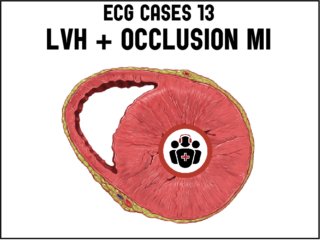
ECG Cases – Making complexes simple is a monthly blog by Jesse McLaren (@ECGcases), a Toronto emergency physician with an interest in emergency cardiology quality improvement and education. Each post features a number of ECGs related to a particular theme or diagnosis (with a focus on acute coronary occlusion), so you can test your interpretation skills. We challenge you with missed or delayed diagnosis, those with false positive diagnosis, and those that had a rapid and correct diagnosis. Cases are followed by a quick summary of the literature that relates to the cases, and we bring it home with practice changing pearls that you can use on your next shift.
Share your interesting ECGs with us!
ECG Cases 13: LVH and Occlusion MI
LVH produces secondary repolarization abnormalities that can mimic STEMI. Signs of occlusion MI in patients with LVH include: new Q waves/loss of R waves, disproportionate and dynamic ST elevation (or ST depression from posterior MI), and hyperacute T waves. In this ECG Cases blog we look at 6 patients who presented with potentially ischemic symptoms and LVH on their ECG. Which had an acute coronary occlusion?
ECG Cases 12: RBBB and Occlusion MI
In this ECG Cases blog we look at 7 patients with RBBB and potentially ischemic symptoms. Which had RBBB and occlusion MI?...
ECG Cases 11: LBBB + Occlusion MI
In ECG Cases 11 - LBBB + Occlusion MI Jesse McLaren runs through 5 patients who present with potentially ischemic symptoms and LBBB and explains the evolution of decision making for cath lab activation criteria. The two most important points are that we should always use the Smith-modified Sgarbossa Criteria to identify occlusion MI in the patient with ischemic symptoms and LBBB, whether old or new, and that those with refractory ischemia and hemodynamic instability from suspected occlusion MI require cath lab activation regardless of the ECG....
ECG Cases 10 – Hyperkalemia: The Great Imitator
Which of the following 9 patients had hyperkalemia? Can you estimate how high their serum potassium was based on the ECG? Jesse MacLaren guides us through 9 ECGs underscoring the fact that while the ECG cannot rule out hyperkalemia, significant hyperkalemia often produces ECG changes in the heart rate (bradycardia, junctional rhythm), electrical conduction (PR prolongation or loss of P waves, QRS prolongation, pacemaker delays), and ST/T waves (Brugada phenocopy, peaked T waves that are narrow/pointy) that can be easily recognized. He suggests when you might pull the trigger on giving empiric calcium treatment based on the ECG finding in this month's ECG Cases...
ECG Cases 8 Cardiovascular Emergencies During The COVID-19 Pandemic
In this ECG Cases blog we look at 6 patients who presented with cardiorespiratory symptoms, possibly from COVID and illustrate the dangers of anchoring, being hypervigilant for cardiovascular complications, and why testing for COVID in patients being admitted for ACS is important...
ECG Cases 9 – First Diagonal Occlusion
Seven patients with ischemic symptoms, none meeting STEMI criteria but all identified by a specific pattern of first diagonal branch occlusion are explored in this ECG Cases blog with Jesse MacLaren who also explains The South African Flag Sign...







